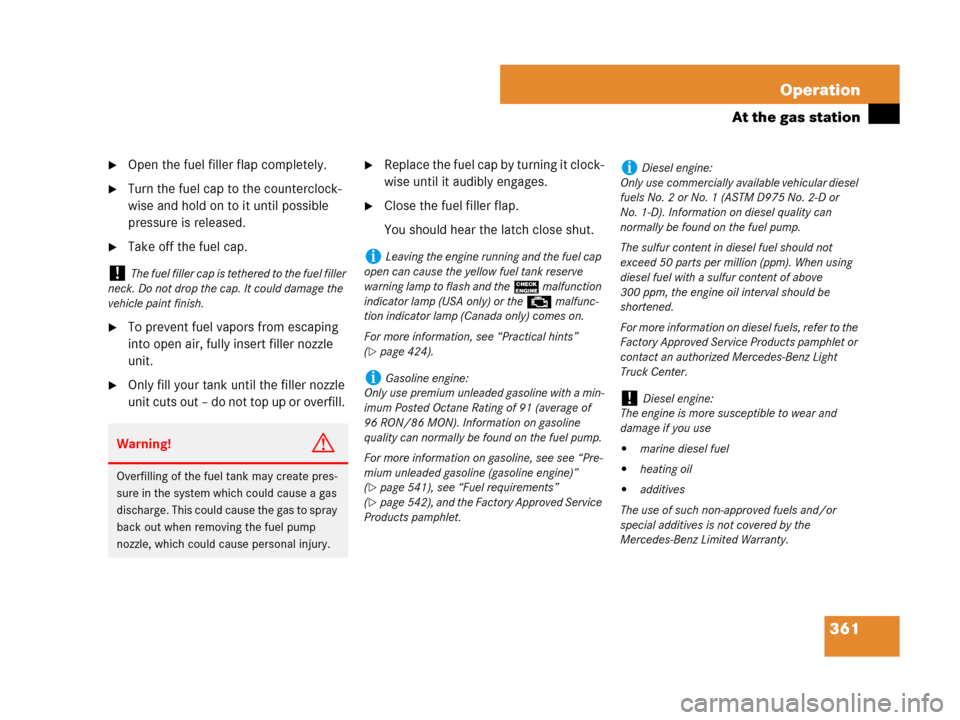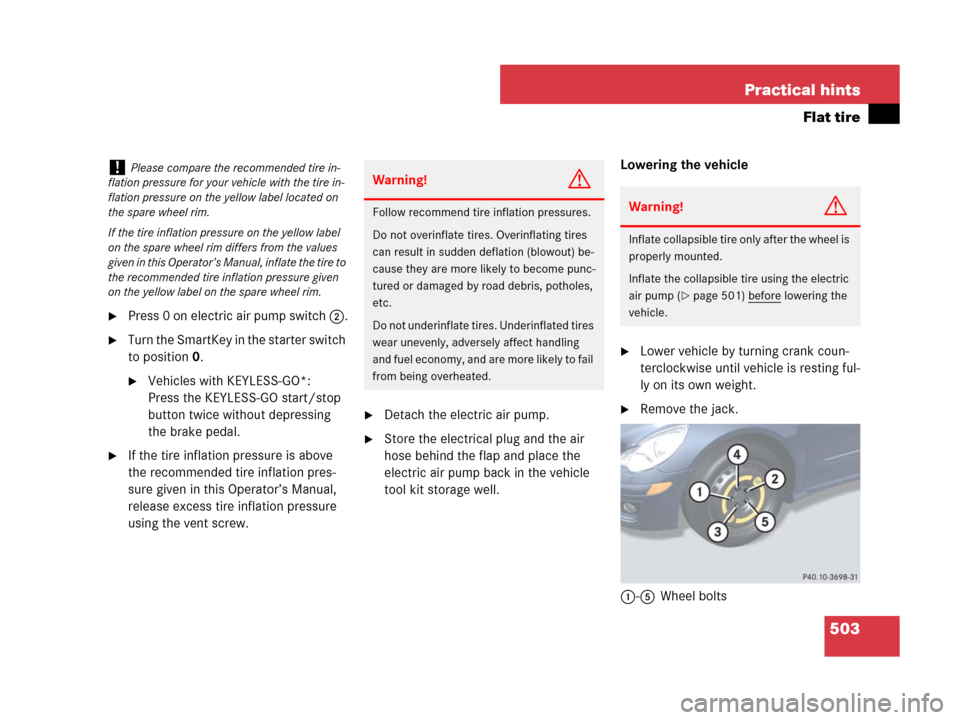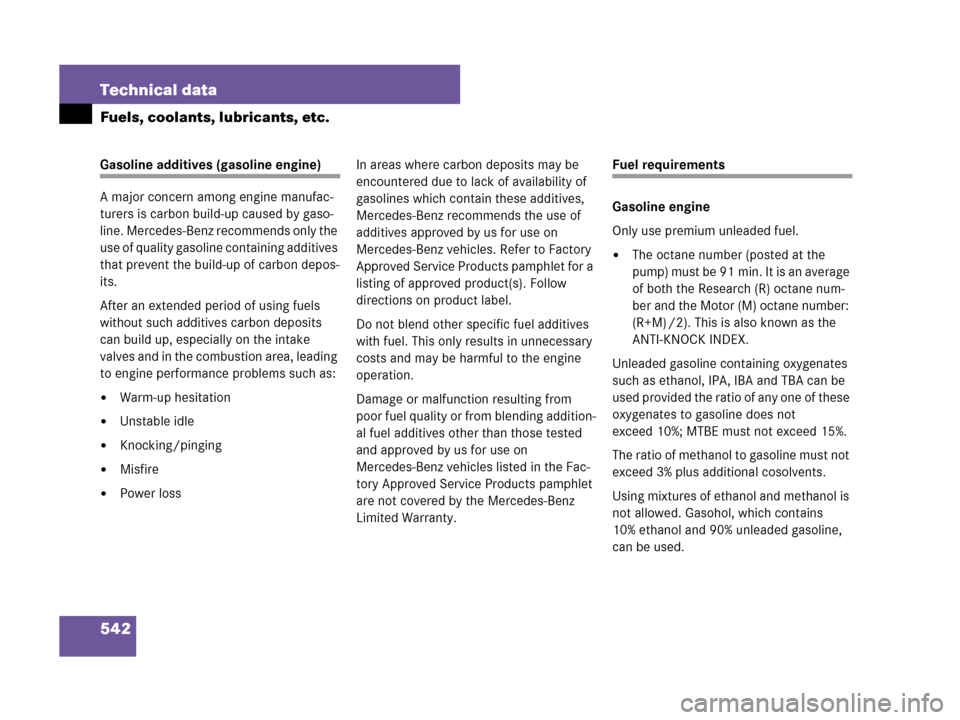Page 362 of 570

361 Operation
At the gas station
�Open the fuel filler flap completely.
�Turn the fuel cap to the counterclock-
wise and hold on to it until possible
pressure is released.
�Take off the fuel cap.
�To prevent fuel vapors from escaping
into open air, fully insert filler nozzle
unit.
�Only fill your tank until the filler nozzle
unit cuts out – do not top up or overfill.
�Replace the fuel cap by turning it clock-
wise until it audibly engages.
�Close the fuel filler flap.
You should hear the latch close shut.
!The fuel filler cap is tethered to the fuel filler
neck. Do not drop the cap. It could damage the
vehicle paint finish.
Warning!G
Overfilling of the fuel tank may create pres-
sure in the system which could cause a gas
discharge. This could cause the gas to spray
back out when removing the fuel pump
nozzle, which could cause personal injury.
iLeaving the engine running and the fuel cap
open can cause the yellow fuel tank reserve
warning lamp to flash and the? malfunction
indicator lamp (USA only) or the± malfunc-
tion indicator lamp (Canada only) comes on.
For more information, see “Practical hints”
(
�page 424).
iGasoline engine:
Only use premium unleaded gasoline with a min-
imum Posted Octane Rating of 91 (average of
96 RON/86 MON). Information on gasoline
quality can normally be found on the fuel pump.
For more information on gasoline, see see “Pre-
mium unleaded gasoline (gasoline engine)”
(
�page 541), see “Fuel requirements”
(
�page 542), and the Factory Approved Service
Products pamphlet.
iDiesel engine:
Only use commercially available vehicular diesel
fuels No. 2 or No. 1 (ASTM D975 No. 2-D or
No. 1-D). Information on diesel quality can
normally be found on the fuel pump.
The sulfur content in diesel fuel should not
exceed 50 parts per million (ppm). When using
diesel fuel with a sulfur content of above
300 ppm, the engine oil interval should be
shortened.
For more information on diesel fuels, refer to the
Factory Approved Service Products pamphlet or
contact an authorized Mercedes-Benz Light
Truck Center.
!Diesel engine:
The engine is more susceptible to wear and
damage if you use
�marine diesel fuel
�heating oil
�additives
The use of such non-approved fuels and/or
special additives is not covered by the
Mercedes-Benz Limited Warranty.
Page 504 of 570

503 Practical hints
Flat tire
�Press 0 on electric air pump switch 2.
�Turn the SmartKey in the starter switch
to position0.
�Vehicles with KEYLESS-GO*:
Press the KEYLESS-GO start/stop
button twice without depressing
the brake pedal.
�If the tire inflation pressure is above
the recommended tire inflation pres-
sure given in this Operator’s Manual,
release excess tire inflation pressure
using the vent screw.
�Detach the electric air pump.
�Store the electrical plug and the air
hose behind the flap and place the
electric air pump back in the vehicle
tool kit storage well.Lowering the vehicle
�Lower vehicle by turning crank coun-
terclockwise until vehicle is resting ful-
ly on its own weight.
�Remove the jack.
1-5Wheel bolts
!Please compare the recommended tire in-
flation pressure for your vehicle with the tire in-
flation pressure on the yellow label located on
the spare wheel rim.
If the tire inflation pressure on the yellow label
on the spare wheel rim differs from the values
given in this Operator’s Manual, inflate the tire to
the recommended tire inflation pressure given
on the yellow label on the spare wheel rim.Warning!G
Follow recommend tire inflation pressures.
Do not overinflate tires. Overinflating tires
can result in sudden deflation (blowout) be-
cause they are more likely to become punc-
tured or damaged by road debris, potholes,
etc.
Do not underinflate tires. Underinflated tires
wear unevenly, adversely affect handling
and fuel economy, and are more likely to fail
from being overheated.Warning!G
Inflate collapsible tire only after the wheel is
properly mounted.
Inflate the collapsible tire using the electric
air pump (
�page 501) before lowering the
vehicle.
Page 543 of 570

542 Technical data
Fuels, coolants, lubricants, etc.
Gasoline additives (gasoline engine)
A major concern among engine manufac-
turers is carbon build-up caused by gaso-
line. Mercedes-Benz recommends only the
use of quality gasoline containing additives
that prevent the build-up of carbon depos-
its.
After an extended period of using fuels
without such additives carbon deposits
can build up, especially on the intake
valves and in the combustion area, leading
to engine performance problems such as:
�Warm-up hesitation
�Unstable idle
�Knocking/pinging
�Misfire
�Power lossIn areas where carbon deposits may be
encountered due to lack of availability of
gasolines which contain these additives,
Mercedes-Benz recommends the use of
additives approved by us for use on
Mercedes-Benz vehicles. Refer to Factory
Approved Service Products pamphlet for a
listing of approved product(s). Follow
directions on product label.
Do not blend other specific fuel additives
with fuel. This only results in unnecessary
costs and may be harmful to the engine
operation.
Damage or malfunction resulting from
poor fuel quality or from blending addition-
al fuel additives other than those tested
and approved by us for use on
Mercedes-Benz vehicles listed in the Fac-
tory Approved Service Products pamphlet
are not covered by the Mercedes-Benz
Limited Warranty.
Fuel requirements
Gasoline engine
Only use premium unleaded fuel.
�The octane number (posted at the
pump) must be 91 min. It is an average
of both the Research (R) octane num-
ber and the Motor (M) octane number:
(R+M) /2). This is also known as the
ANTI-KNOCK INDEX.
Unleaded gasoline containing oxygenates
such as ethanol, IPA, IBA and TBA can be
used provided the ratio of any one of these
oxygenates to gasoline does not
exceed 10%; MTBE must not exceed 15%.
The ratio of methanol to gasoline must not
exceed 3% plus additional cosolvents.
Using mixtures of ethanol and methanol is
not allowed. Gasohol, which contains
10% ethanol and 90% unleaded gasoline,
can be used.